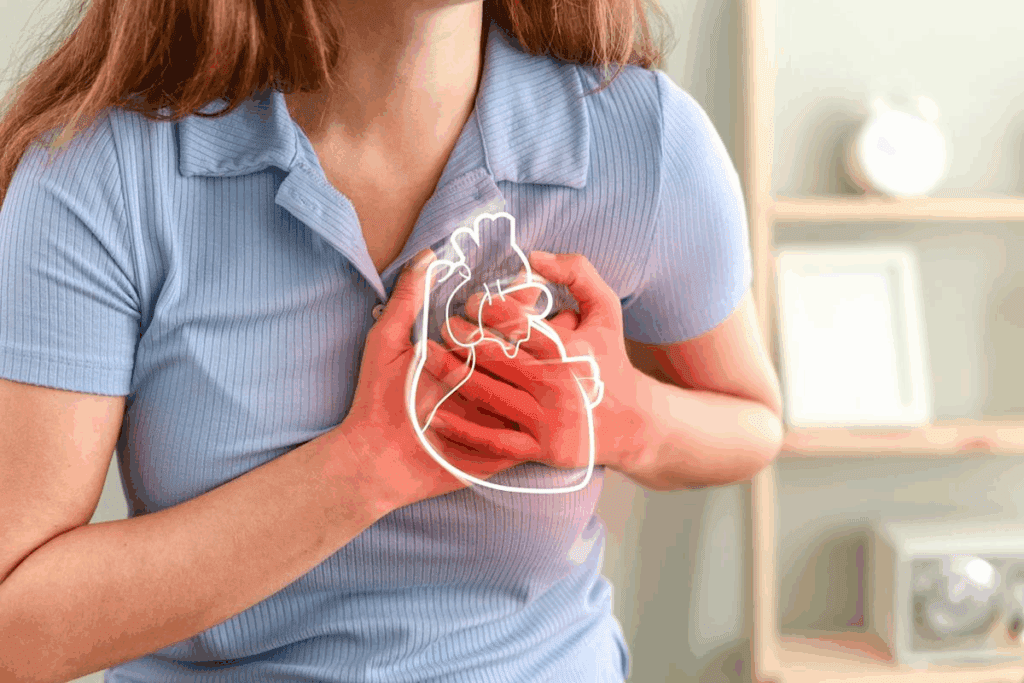Last Updated on October 31, 2025 by Batuhan Temel

At Liv Hospital, we know how heart arrhythmias affect people’s lives. Treating irregular heartbeats needs a precise and gentle method. That’s why cardiac catheter ablation is key. It uses radiofrequency energy to destroy the heart tissue causing arrhythmias.
Our team uses advanced catheter ablation techniques to fix heart rhythms. This makes life better for our patients. We’re all about giving top-notch care and support every step of the way.

Cardiac arrhythmias are conditions where the heart beats abnormally. They can affect different parts of the heart. This leads to various symptoms and complications.
Several types of cardiac arrhythmias significantly impact patients. Atrial fibrillation (AFib) is common, causing rapid and irregular heartbeats. Other types include supraventricular tachycardia (SVT) and atrial flutter.
| Type of Arrhythmia | Description | Common Symptoms |
| Atrial Fibrillation (AFib) | Rapid and irregular heartbeats | Palpitations, shortness of breath, fatigue |
| Supraventricular Tachycardia (SVT) | Rapid heartbeats originating above the ventricles | Rapid heartbeat, dizziness, chest discomfort |
| Atrial Flutter | Atria is beating too quickly | Palpitations, shortness of breath, fatigue |
Irregular heart rhythms can greatly impact daily life. They cause symptoms like palpitations, fatigue, and shortness of breath. These symptoms can make it hard to do daily activities and exercise.
Arrhythmia episodes can also cause anxiety and stress. This affects mental health and quality of life. It’s important to understand the impact of these irregular heart rhythms.
Recognizing the types and effects of cardiac arrhythmias is key. Cardiac catheter ablation is a highly effective treatment. It helps patients control their heart health and improve their quality of life.

Cardiac catheter ablation is a new way to treat heart arrhythmias. It’s a minimally invasive procedure. It uses catheters to send energy to destroy the bad electrical pathways in the heart.
During the procedure, doctors use special techniques to find the bad heart tissue. They then use energy like radiofrequency or cryoablation to destroy it. The energy goes through a catheter to the heart.
The goal is to get rid of the bad pathways without harming the good heart tissue. This is more precise than medicine, which can affect the whole body.
Medicine is often the first choice for arrhythmias. It tries to control symptoms and keep the heart rhythm steady. But, it can have side effects and may not work for everyone.
Catheter ablation is a more direct treatment. It aims to get rid of the bad pathways for good. This can mean less or no medicine is needed in the long run.
Choosing between ablation and medicine depends on many things. These include the type of arrhythmia, patient preferences, and overall health. A cardiologist or electrophysiologist must evaluate each case to decide the best treatment.
Radiofrequency ablation is the top choice for treating heart arrhythmias. It targets and destroys abnormal heart tissue. This is done using radiofrequency energy.
It’s key to know how this treatment works. It’s favored by many doctors because it can cure arrhythmias. This makes it a powerful tool in heart care.
Radiofrequency energy heats a small heart tissue area. This destroys the bad electrical pathways causing arrhythmias. A catheter, guided by imaging, does this.
This method is effective because it directly fixes the problem. Patients see big improvements in their symptoms and life quality.
Doctors like radiofrequency ablation for many reasons. It works well, is safe, and offers long-term relief. It’s also less invasive than surgery.
| Benefits of Radiofrequency Ablation | Description |
| High Success Rates | Radiofrequency ablation is very effective, with success rates over 90% in some cases. |
| Minimally Invasive | The procedure uses a catheter, avoiding open-heart surgery and causing less damage. |
| Quick Recovery | Patients recover fast, often returning to normal activities in a few days. |
Exploring radiofrequency ablation shows it’s a strong solution for heart arrhythmias. Understanding its science and benefits highlights its importance in heart care.
Cardiac catheter ablation is a minimally invasive procedure. It has a big advantage: it cuts down recovery time a lot. This is compared to traditional open-heart surgery.
This method uses small punctures in the body, usually in the groin, neck, or arm. It gets to the heart without much trouble. This way, patients face less pain and scarring after the procedure.
The spot where the catheter goes in depends on the patient and the heart issue. Common spots are:
Doctors pick the best spot for each patient’s needs.
The radial ablation heart procedure has big benefits. It uses the radial artery in the arm. This means:
Using a small incision and the right spot, catheterization ablation is safe and works well. Patients get better quicker and can go back to their lives sooner.
Advanced 3D mapping systems have changed how precise cardiac catheter ablation procedures are. They let electrophysiologists see the heart’s electrical system clearly. This helps them find and treat areas that cause arrhythmias well.
Electrophysiologists use 3D mapping to make detailed heart models. This tech shows them the heart’s electrical paths. It helps them spot where abnormal signals are.
With 3D mapping, they can:
Seeing things in real-time is key with 3D mapping. It lets doctors see how the ablation works right away. This makes the procedure more precise and effective.
The good things about seeing things live include:
| Benefit | Description |
| Improved Accuracy | Real-time data helps target arrhythmogenic areas better |
| Enhanced Safety | Seeing things right away helps avoid problems |
| Increased Efficiency | Quick changes make the ablation smoother |
Thanks to 3D mapping and real-time views, doctors can do better with cardiac catheter ablation. This tech is a big step forward in treating heart arrhythmias.
RFA cardiac ablation is a top choice for treating heart arrhythmias. It has a success rate over 90% for some conditions. This method is a big step forward, giving patients a less invasive option with great benefits.
The success of RFA cardiac ablation changes with the arrhythmia type. Supraventricular tachycardia (SVT) and atrial flutter see the best results, with success rates often over 90%. For example, a study showed that over 95% of SVT patients stayed symptom-free long-term.
| Arrhythmia Type | Success Rate | Recurrence Rate |
| Supraventricular Tachycardia (SVT) | 95% | 5% |
| Atrial Flutter | 90% | 8% |
| Atrial Fibrillation | 70-80% | 20-30% |
Many things affect how well RFA cardiac ablation works. The type of arrhythmia is key, as some respond better than others. Also, patient selection matters a lot. Patients with certain health issues or who didn’t get better with other treatments might have different results.
The operator’s expertise is also very important. The skill and experience of the doctor doing the procedure can greatly affect success rates.
Advanced technologies like 3D mapping systems and contact force sensing catheters also play a big role. They help make the procedure more precise and effective, leading to better results.
Knowing what affects treatment success and the success rates for different arrhythmias helps both patients and doctors. This knowledge helps make better choices about using RFA cardiac ablation.
After radiofrequency catheter ablation, patients start a recovery phase watched by doctors. This time is key for the procedure’s success and patient safety.
Right after the procedure, patients go to a recovery room. There, doctors check for any immediate issues like bleeding or heart rhythm changes. They also teach patients how to manage any pain or discomfort at home.
Most patients can go home the same day or the next. It’s best if someone stays with them for the first night.
“The recovery process after radiofrequency catheter ablation is generally well-tolerated, with most patients experiencing minimal discomfort.” An Expert Cardiologist
Long-term care includes regular check-ups with a cardiologist. These visits are to check the heart’s rhythm and adjust medications. They are key for seeing if the procedure worked and for addressing any issues.
| Follow-up Activity | Timeline | Purpose |
| Initial Follow-up | 1-2 weeks post-procedure | Check for complications, assess symptom relief |
| Holter Monitor Test | 1-3 months post-procedure | Monitor heart rhythm for an extended period |
| Medication Adjustment | Ongoing, as needed | Manage symptoms, prevent arrhythmia recurrence |
Patients should keep a log of their symptoms. This helps during follow-up visits. By monitoring their condition and following the recommended care plan, patients can get the most from radiofrequency catheter ablation.
It’s important for patients to know the risks of cardiac radiofrequency ablation before they decide to have it. This treatment is usually safe and works well, but there are some risks. Knowing about these risks helps patients make the best choices for their health.
Most people who have this treatment feel some side effects, but they are usually mild and don’t last long. Some common side effects include:
These side effects are usually easy to handle and go away quickly. But, it’s key for patients to follow their doctor’s instructions after the treatment to avoid more problems.
Even though they are rare, serious problems can happen with this treatment. These include:
It’s important for patients to know about these serious complications and talk about their own risks with their doctor. Even though these problems are rare, knowing about them helps patients spot symptoms early and get help fast if needed.
By understanding both the common side effects and the rare but serious complications of cardiac radiofrequency ablation, patients can make informed choices about their treatment. It’s about weighing the benefits of the treatment against the risks. This should be talked about in detail with a healthcare provider.
The world of RF ablation heart technologies has seen big changes. These changes have made treating heart arrhythmias better and safer.
One key improvement is the switch to contact force sensing catheters. These new catheters help doctors apply the right amount of pressure. This makes the treatment more effective and cuts down on risks.
Old catheters didn’t give doctors feedback on pressure. But, contact force sensing catheters have sensors that measure pressure. This makes treatments safer and more effective.
| Feature | Conventional Catheters | Contact Force Sensing Catheters |
| Force Feedback | No real-time feedback | Real-time force measurement |
| Ablation Efficacy | Variable | Improved consistency |
| Complication Risk | Higher | Reduced |
New ideas like pulsed-field ablation and high-power short-duration ablation are making RF ablation better. They’re showing great results in treating heart arrhythmias.
Pulsed-field ablation creates lesions without heat damage. High-power short-duration ablation is faster and more efficient. These methods are improving treatment outcomes.
As these technologies get better, so will the results for patients. The future of treating heart arrhythmias with RF ablation looks bright. Ongoing research aims to make treatments even safer and more effective.
Getting ready for your catheter ablation is key. This treatment helps with heart arrhythmias. Being prepared can make a big difference in how well you do.
Before the procedure, you’ll have tests to check your heart and health. These tests help doctors plan and see if there are any risks.
These tests are important to find the best way for your catheter ablation. They also make sure you’re a good candidate for it.
Managing your medications is a big part of getting ready. Some drugs might need to be changed or stopped before the procedure to lower risks.
| Medication Type | Pre-procedure Instructions | Post-procedure Instructions |
| Blood Thinners | May need to be stopped a few days before | Resume as directed by your doctor |
| Anti-arrhythmic Medications | May be continued or adjusted | Continue as prescribed |
It’s important to follow your doctor’s advice on medications. Always talk to your healthcare provider before changing your medications.
Knowing what to do for tests and medications helps you feel ready for your catheter ablation. If you have any worries or questions, ask your healthcare team.
Radiofrequency ablation is a top choice for treating some heart arrhythmias. It offers many benefits for those with specific heart issues. This treatment can greatly improve your life and lessen symptoms of irregular heartbeats.
This method is known for being minimally invasive. It uses advanced 3D mapping technology and has high success rates for certain arrhythmias. It’s a game-changer for managing heart arrhythmias, giving a break from long-term meds.
Not everyone is a good candidate for radiofrequency ablation. It’s key to talk to a doctor to see if it’s right for you. Weighing the pros and cons helps you make a smart choice about your treatment.
Radiofrequency ablation keeps getting better, bringing hope to those with heart arrhythmias. We suggest you talk to a healthcare expert. They can help you understand if this treatment could be good for your heart condition.
Cardiac catheter ablation is a procedure to treat heart rhythm problems. It uses energy to create scar tissue. This blocks irregular electrical signals.
Radiofrequency ablation treats many arrhythmias. This includes atrial fibrillation, supraventricular tachycardia, and atrial flutter.
It uses radiofrequency energy to destroy tissue causing heart rhythm problems. This helps restore a normal rhythm.
Catheter ablation has many benefits. It reduces the risk of medication side effects. It can also provide a more lasting solution, avoiding ongoing medication.
RFA cardiac ablation has a high success rate. It’s over 90% for some arrhythmias. Success rates vary based on the arrhythmia and patient factors.
Recovery involves a short hospital stay. You’ll follow post-procedure instructions. Long-term monitoring is also needed to ensure a stable heart rhythm.
Risks include groin bruising and rare but serious complications like cardiac tamponade. It’s important to discuss these risks with a healthcare professional.
Preparation includes pre-procedure testing and medication management. This ensures safety and the best outcomes.
New advancements include contact force sensing catheters and pulsed-field ablation. These improve outcomes in catheterization ablation.
Radiofrequency ablation is suitable for some arrhythmias. A healthcare professional will determine if it’s right for you, based on your arrhythmia.
National Center for Biotechnology Information. (2025). Cardiac Catheter Ablation 7 Essential Facts About Radiofrequency. Retrieved from https://www.ncbi.nlm.nih.gov/pmc/articles/PMC11918750/
Subscribe to our e-newsletter to stay informed about the latest innovations in the world of health and exclusive offers!
WhatsApp us